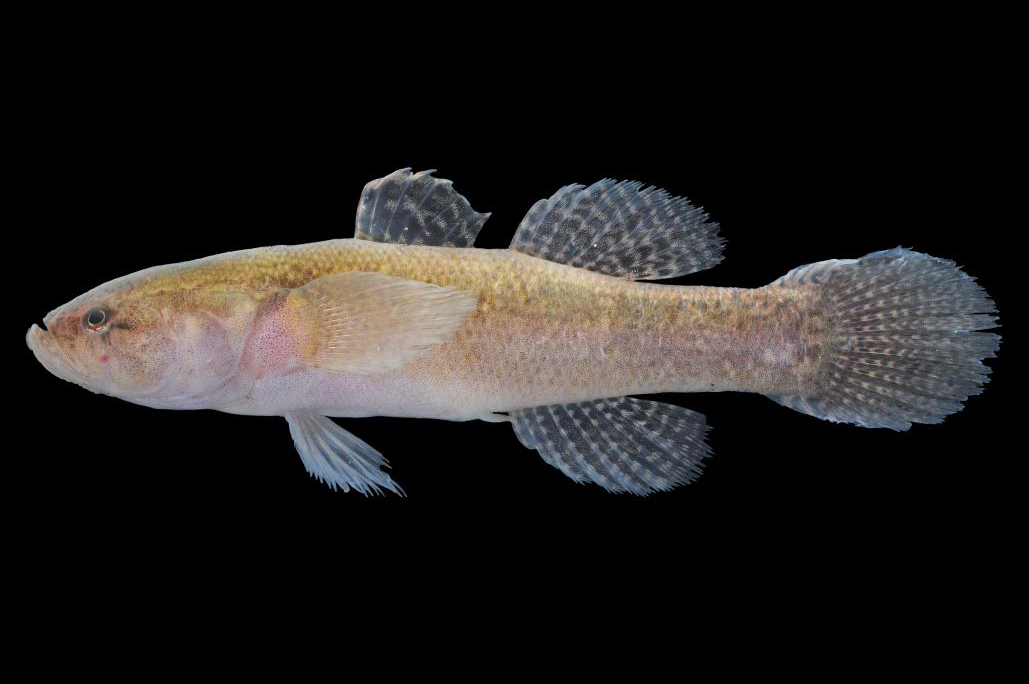- Classification
- ACTINOPTERYGII
- PERCIFORMES
- ELEOTRIDAE
- Eleotris
- melanosoma
Black Spine-cheek Gudgeon, Eleotris melanosoma Bleeker 1852

Black Spine-cheek Gudgeon, Eleotris melanosoma. Source: Dinh D. Tran, FiMSeA / http://ffish.asia. License: CC by Attribution
Black Spine-cheek Gudgeon, Eleotris melanosoma Bleeker 1852
More Info
|
Distribution |
Known in northern Australia from Lizard Island to Innisfail, QLD. The species occurs elsewhere in the tropical Indo-west Pacific, and has been introduced to the Panama Canal Zone. Inhabits estuarine and freshwaters, usually on muddy, sandy or gravel substrates. Adults inhabit brackish estuaries and medium to large size rivers, and shelter among leaf litter, woody debris and the submerged bank vegetation of freshwater streams. |
|
Features |
Dorsal fin VI + I, 8; Anal fin I, 8; Pectoral fin 17-20; Pelvic fin I, 5; Tr Sc 11-18; Longitudinal scale series 46-58; Predorsal scales 37-53; Scales crossing mid caudal peduncle 11-12; Gill rakers 12-13. Body elongate, cylindrical anteriorly, compressed posteriorly, depth 18.1-22.2% SL; length of caudal peduncle less than twice its depth. Head pointed, depressed, 28.5- 36.4% SL; frontal profile straight to a little concave. Snout pointed, as long as eye, tip at level of upper part of eye. Anterior nostril tubular, near margin of snout. Eye 18.1-22.2% head length, inter-orbital 1.0-1.7 in eye diameter. Lower jaw prominent, upper reaching to or just past middle of eye; jaw teeth in many rows, small, outer and inner rows slightly enlarged, subequal. Preopercular spine conical, curved. Interorbital space with 2 longitudinal mucous canals, and short transverse canals laterally towards eye; 2 longitudinal mucous canals on cheek, crossed by canals radiating under eye. Supraopercular groove distinct. No pores on head. 2 longitudinal rows of papillae on opercle meeting posteriorly. Scales of body ctenoid posteriorly, cycloid anteriorly; lateral line absent, snout naked, head scaled above between and behind eye, on cheek and opercle. Two dorsal fins, first dorsal obtuse, about half depth of body, second, third and fourth rays longest; second dorsal and anal fin higher than first dorsal, about as high as body depth. Pectoral fin obtuse, about as long as head. Pelvic fins separate, slightly shorter than head. Caudal fin obtuse, slightly shorter than head. |
|
Size |
To around 18cm. |
|
Colour |
Dusky red or dusky green above, paler below; usually dusky blotch dorsally on pectoral fin base. Fin membranes dusky to violet, rays orange to dusky; dark spots on rays of dorsal, caudal and pectoral fins; dorsal and anal fins with dark longitudinal stripes. |
|
Feeding |
Feeds mainly on insects, crustaceans and small fishes. |
|
Biology |
Oviparous, benthic spawners. Eggs are small and numerous. Likely to have a marine larval phase. |
|
Similar Species |
Distinguished from other species in the genus Eleotris in having 46–58 lateral row scales, usually 18–19 pectoral rays, 12–13 gill rakers on the first gill arch and two longitudinal rows of papillae on the opercle meeting posteriorly. This species has been confused with Eleotris fusca. |
|
Species Citation |
Eleotris melanosoma Bleeker, P. (1852). Nieuwe bijdrage tot de kennis der ichthyologische fauna van Ceram. Nat. Tijdschr. Ned. Ind. 3: 689–714 [705]. Wahai, Ceram and Sumatra occidentalis, Indonesia. |
|
Author |
Martin F. Gomon |
Black Spine-cheek Gudgeon, Eleotris melanosoma Bleeker 1852
References
Akihito. 1967. On four species of the gobiid fishes of the genus Eleotris found in Japan. Japanese Journal of Ichthyology 14(4/6): 135-166.
Allen, G.R. 1991. Field guide to the freshwater fishes of New Guinea. Christensen Research Institute, Madang, Papua New Guinea.
Allen, G.R., Midgley, S.H. & Allen, M. 2002. Field Guide to the Freshwater Fishes of Australia. Perth : Western Australian Museum 394 pp.
Kuiter, R.H. & T. Tonozuka, 2001. Pictorial guide to Indonesian reef fishes. Part 3. Jawfishes - Sunfishes, Opistognathidae - Molidae. Zoonetics, Australia. pp. 623-893.
Kottelat, M., Whitten, A.J., Kartikasari, S.N. & Wirjoatmodjo, S. 1993. Freshwater fishes of Western Indonesia and Sulawesi. Periplus Editions, Hong Kong.
Larson, H. & Ng, H.H. 2012. Eleotris melanosoma. The IUCN Red List of Threatened Species. Version 2014.3.
Maeda, K., Mukai, T. & Tachihara, K. 2011. Newly collected specimens of the sleeper Eleotris acanthopoma (Teleostei: Eleotridae) from French Polynesia indicate a wide and panmictic distribution in the west and south Pacific. Pacific Science 65: 257-264.
Maeda, K. & Tachihara, K. 2004. Instream distributions and feeding habits of two species of sleeper, Eleotris acanthopoma and Eleotris fusca, in the Teima River, Okinawa Island. Ichthyological Research 51: 233-240.
McDowall, R.M. 1988. Diadromy in fishes: migrations between freshwater and marine environments. Croom Helm, London.
Myers, R.F. 1999. Micronesian reef fishes: a comprehensive guide to the coral reef fishes of Micronesia, 3rd ed. Coral Graphics, Barrigada, Guam. 330 pp.
Pusey B., Kennard M. & Arthington A. 2004. Freshwater Fishes of North-Eastern Australia. CSIRO Publishing, Collingwood Australia. 684 pp.



